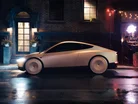Tesla’s Cybercab Robotaxi Pioneers Autonomous Vehicle Future

The pace of innovation in the automotive landscape is accelerating, with cutting-edge technologies like autonomous vehicles and Artificial Intelligence (AI) emerging as game-changers.
The rippling effect these technologies are creating is reshaping urban mobility and altering human interaction with vehicles, anticipating not only a profound evolution in road dynamics but also substantial urban and environmental enhancements.
Major tech entities alongside traditional car manufacturers are increasingly leaning into self-driving technology investments.
This transformative journey in transportation forecasts a revolutionary impact on aspects ranging from city infrastructures to traffic incidence rates.
In a remarkable move in this direction, Tesla has unveiled its latest leap into the future — the Cybercab.
The birth of Tesla's Cybercab
The introduction of Cybercab signifies a strategic pivot for Tesla from mass-produced EVs to AI-driven autonomous mobility options.
Revealed during the ‘We, Robot’ conference at Warner Bros Studios in Burbank, California, the Cybercab breaks the mould with its two-seater capacity and exotic butterfly doors, conspicuously omitting any traditional vehicular controls like steering wheels or pedals.
Tesla’s CEO, Elon Musk, says the Cybercab would be competitively priced below US$30,000 and anticipates production kickoff before 2027.
Although achieving this timeline remains somewhat tentative, reflecting inherent challenges in fostering full autonomy within vehicles.
Alongside the Cybercab, Musk showcased an early concept of the Cybervan, pitched to carry as many as 20 individuals, underpinning Tesla's ambition to diversify its autonomous transportation portfolio.
Reimagining Future Transport
Highlighting the safety and efficiency prospects of autonomous vehicles, Musk points out that invaluable technologies such as AI and cameras would be instrumental in navigation processes, diverging from the hardware-centric approaches like lidar technology adopted by Tesla's rivals.
He claimed that self-driving cars could potentially be: "10 to 20 to 30 times safer than a human.”
While this method could potentially reduce costs, it faces stern technological and regulatory challenges.
However, Musk remains enthusiastic, disclosing aspirations to achieve a mere US$0.20 per mile operating cost for the Cybercab, plummeting even further for the Cybervan, upon its realisation.
In addition, Tesla intends to introduce inductive charging capabilities to these models, phasing out the conventional need for physical chargers.
However, industry insiders sustain a cautious stance on the rapid dissemination of robotaxi facilities, emphasising the extended timeframes potentially necessitated by regulatory compliance and assurance of reliability across varied environmental scenarios.
Wider implications
Tesla’s stride into the robotaxi domain pitches it in direct competition with several tech giants and automotive innovators.
For instance, Alphabet's Waymo has been successfully operating unmanned robotaxis in parts of Phoenix and San Francisco.
In the same vein, companies like Amazon's Zoox are refining their fleet of purpose-built autonomous vehicles.
Musk is optimistic, nonetheless, anticipating that fully autonomous, unsupervised Full Self-Driving (FSD) functionalities could be operational in specific models as soon as 2025 in Texas and California.
The far-reaching impacts of such innovations extend beyond just technological advancements; they promise to redefine urban planning, modify transportation frameworks and reshape employment landscapes within the automotive and transportation industries.
Cities across the globe, grappling with congestion and pollution, might find solace in these sustainable transport alternatives.
Yet, Tesla’s ambitious autonomous vehicle projects, like the Cybercab, ought to surpass not just technological hurdles but also intricate regulatory landscapes and establish a strong public trust to flourish.
"We do expect actually to start fully autonomous unsupervised FSD in Texas and California next year,” Elon says.
“And that's obviously with the Model 3 and Model Y, and then we expect to be in production with the Cybercab which is really highly optimised for autonomous transport."
Receive the next edition of ClimateTech Magazine by signing up for its newsletter.
As part of this portfolio, make sure you check out Sustainability Magazine and also sign up to our global conference series - Sustainability LIVE.
Also check out our Sister Brand, Energy Digital.

